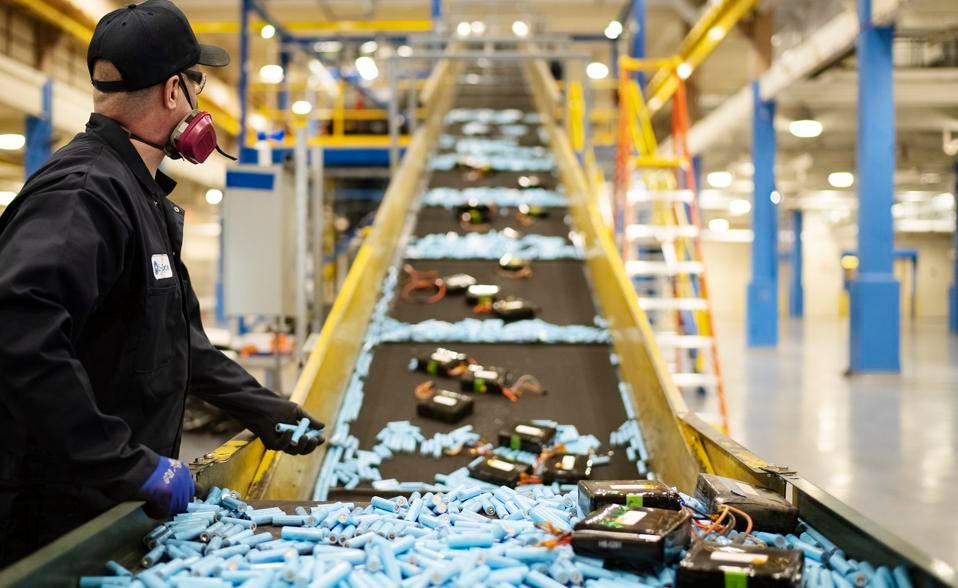Linnaeus University researchers have developed a technique for recycling batteries that is safe for the environment and has the potential to be applied on a massive scale. In the process of recycling batteries, urine and acetic acid are used to make a liquid solvent that is used to get back more than 97% of the cobalt.
This research was published in the journal ACS Omega under the title “Highly Efficient Recovery and Recycling of Cobalt from Spent Lithium-Ion Batteries Using an N-Methylurea–Acetamide Nonionic Deep Eutectic Solvent.”
Given the growing need for lithium-ion batteries and the limited supply of important battery metals like cobalt, it seems pretty clear that we need a way to recycle batteries that is both effective and efficient. The growing demand for lithium-ion batteries is driving up demand for cobalt, which is one of the primary components of these batteries. This trend is anticipated to continue in the foreseeable future. Despite this, recycling of batteries is only done on a limited scale at the moment.
The new approach to recycling batteries that the researchers have developed has the potential to pave the way for the development of a more environmentally friendly battery industry while also resolving two of the most significant issues that exist with the recycling process that is currently in place, i.e high energy costs and hazardous waste. In order to extract the cobalt and disperse the lithium cobalt oxide, a substance that is employed in the production of lithium-ion batteries, the researchers made use of a liquid solvent.
“The solvent is a combination of two readily available substances: a simple derivate of urea, which is naturally occurring in urine, and acetamide, which can easily be retrieved from acetic acid. The solvent is a combination of two readily available substances: a simple derivate of urea, which is naturally occurring in urine.” explained Subramanian Suriyanarayanan, one of the researchers behind the new method.
The procedure requires lower temperatures
The fact that the researchers’ solvent enables the cobalt battery reprocessing process to take place at temperatures significantly lower than those currently used is the primary advantage offered by the substance.
“We found that 180 degrees Celsius produced the best results for our response.” According to Nicholls, “this makes our method significantly more energy efficient than the commercial options available today, such as pyrometallurgy, which require extremely high temperatures, often exceeding 1,400 degrees Celsius.”
Potential to be implemented on a large scale
Researchers were able to get more than 97% of the cobalt out of the lithium cobalt oxide by letting it soak in a heated solvent for two days.
After the cobalt had been extracted, it was put to use in the manufacturing of new batteries by specialists at the Indian Institute of Technology in Madras. These batteries, in turn, have been recycled while retaining their effectiveness.
The researchers think that the results bring us one step closer to making batteries that are better for the environment, which is important for the switch to clean energy.
“The combination of readily available and relatively harmless substances with high energy efficacy gives the potential for our method to work for large-scale extraction.” said Nicholls. “
Methods of recovering batteries currently in use and their disadvantages
There are primarily three different ways that lithium-ion batteries can be recycled to recover valuable metals.
The first technique is the process of pyrometallurgy, which involves separating metals at extremely high temperatures, around 1,400 degrees Celsius. This results in high energy costs and the production of harmful gases.
The second technique is called hydrometallurgy, and it involves the use of different chemical solvents to separate the metals. Even though this method makes it less likely that dangerous gases will be made, large amounts of chemical compounds that could be dangerous are still needed.
Finally, the third process of biometallurgy separates metals using bacteria, but it also requires the addition of other substances to speed up the reaction. The procedure has a negative impact on the surrounding ecosystem and comes at a high financial cost.
Because of the growing demand for battery metals, it is essential that a recycling process for batteries be developed that is both kind to the environment and efficient in terms of cost in order to guarantee the continuity of the cyclical battery supply chain.



Leave A Comment